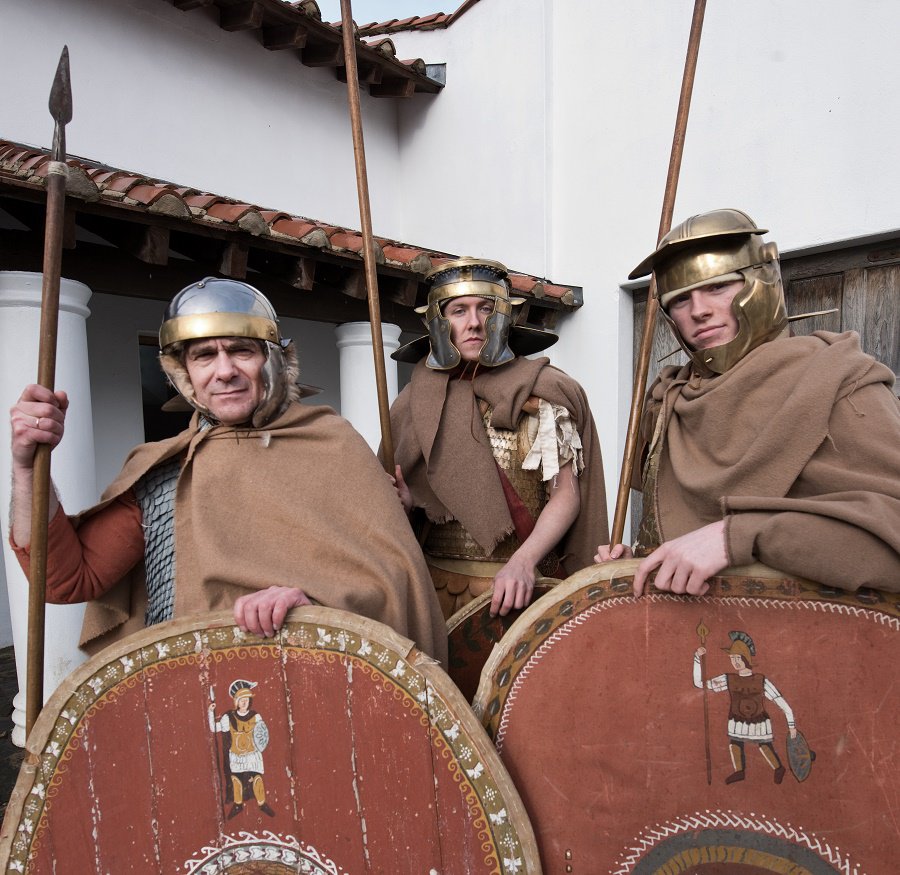The Roman Army at Arbeia

The Roman Army at Arbeia
At the time Arbeia was built, the Roman army had conquered a large area, creating an Empire that stretched from Syria and North Africa to Scotland. A soldier’s main task was to defend the frontiers of Rome so they were well organised and well equipped. Roman soldiers were either legionaries or auxiliaries. Legionaries were at Arbeia to build the fort and left when it was finished, while auxiliaries garrisoned the fort for a further 250 years. A legionary soldier was a Roman citizen but an auxiliary soldier was not, auxiliary soldiers were recruited from the tribes that the Romans conquered. In this way, the Roman army was made up of people from all over the Roman Empire. Wherever they were from, Roman soldiers had to learn Latin as this was the language used in the army. An auxiliary solder could become a Roman citizen after years of loyal service or in return for particular acts of bravery.
Both auxiliaries and legionaries were highly skilled soldiers. A Roman soldier’s life was hard and army discipline was strict. However, Roman soldiers were well paid so there was no shortage of young men wanting to join. Most soldiers stayed in the army for around 20 years.
Roman soldiers were encouraged to keep themselves clean and fit. They kept fit by training in full amour with their weapons (around 2 hours a day) and by running. All soldiers were able to use the garrison’s Bath House to keep clean but they also used it for socialising and playing games.
Roman soldiers were very well trained. If soldiers showed bravery in battle, they were rewarded with a wreath of laurel leaves or oak, called a corona. It was a great honor! What the soldiers wore depended on the type of soldier they were, what they were doing and when they served. Styles can change a lot in 400 years! Generally, auxiliary soldiers wore ringmail suits over their tunics and had longer swords than legionary soldiers. They also used oval shields while legionary soldiers had curved rectangular ones. All Roman soldiers wore cloaks and boots or sandals with iron studs on the sole.
Cavalry were also an important part of the Roman army. Although we have no evidence remaining of cavalry barracks at Arbeia, it is very likely that there were some. Even though the forts were very strong, Romans preferred to ride out and meet the enemy rather than defend their forts.
In a cavalry barrack each of the troop of 30 men was commanded by a Decurion, similar in rank as a Centurion, he lived there with his wife and family.
Roman soldiers served in units of infantry (foot soldiers) or cavalry (on horses) or a mixture of both. An infantry unit was called a cohort (Cohors in Latin). Each unit had a number and a reference to where they came from. The names of the two units known at Arbeia are the Fifth Cohort of Gauls, which means they were the fifth unit of soldiers from France (they had 120 cavalrymen and 480 infantrymen) and the other was the Boatmen from the Tigris. As their name suggests they probably had special skills.
There were 80 men in a century and 6 centuries made a cohort (around 480 men) there
were 10 cohorts in a legion (4800 men in total) but additional men such as clerks, doctors
and craftsmen made the legion nearer 5000 men.
The person in charge of the legion was a Legate. He was usually a young man in his 30s who had some military experience. He was usually from a wealthy family.
Every legion had a standard-bearer, an eagle bearer and an augur who read natural signs to foretell the future and determine the will of the gods such as by looking at the flights of and listening to the songs of the birds.
The Barracks are the buildings where soldiers lived and slept.
The barracks at Arbeia housed 40 soldiers and a Centurion who lived there with his family. The barracks had two small rooms for every eight soldiers. Some historians think that soldiers might have shared a bed with another soldier (hot- bedding) but there is no clear evidence of this or that Roman soldiers used bunk beds at Arbeia.
Archaeological evidence has informed the reconstruction of the Barrack Block, as it was in the Arbeia Fort in the 3rd Century. The barracks were33m long and 7m wide, which we know from the remaining foundations. The external walls were of stone and built up to the roof. The interior walls were constructed of waddle and daub, a combination of wood, mud, straw and dung.
The soldiers who lived in this barrack were Cohors Quinta Gallorum – the Fifth Cohort of Gauls. The barrack was divided up into apartments called Contubernia in Latin.
Excavation has shown that there were cooking fires or ovens in the front room, which would suggest that the soldiers cooked their food, ate and stored their equipment in this one room. Soldiers were given rations of bread, beef, olive oil, wine and grain to bake bread. The other room was used for sleeping. Evidence also tells us that soldiers had a box for personal possessions, which they kept under the bed.
The Centurion was given a separate house with four rooms at one end of the barracks. He was able to live there with his wife, family and slave(s) and possibly junior officers. The extra space given to the Centurion shows how important he was. His rooms take up the space where 16 men could sleep.
Centurions were named as such because initially they would have been in charge of 100 men but this is thought to have dropped to about 80 quite quickly. Because of the number and size of the barracks at Arbeia, it is thought that here he may only have been responsible for the 40 men.
A lot of glass was found on site during excavations so historians believe the barracks may have had windows made of thick, translucent Roman glass. There was no toilet in the barrack but there was one nearby used by all of the soldiers. At night, they would use a bucket. It is likely the soldiers used moss as toilet paper. A second bucket in the room would have been used for water for drinking, cooking and cleaning.




